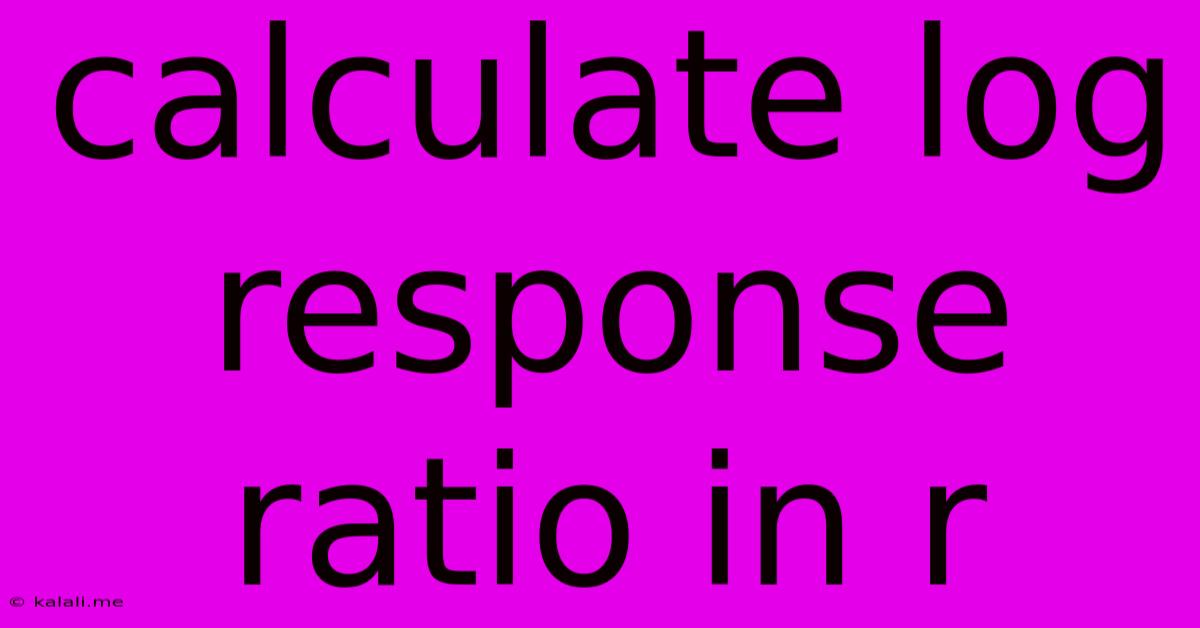Calculate Log Response Ratio In R
Kalali
May 23, 2025 · 3 min read

Table of Contents
Calculating Log Response Ratios in R: A Comprehensive Guide
This article provides a comprehensive guide on how to calculate log response ratios (LRRs) in R, a powerful statistical programming language widely used in data analysis. We'll cover different methods, handle potential issues, and demonstrate practical applications. Understanding LRRs is crucial for meta-analysis and comparing effect sizes across studies, particularly when dealing with ratios or proportions.
What is a Log Response Ratio?
The log response ratio (LRR) is a popular effect size measure used to compare the difference between two groups, particularly when the outcome variable is a rate, proportion, or count. Unlike simpler methods, LRR accounts for the inherent variability of proportions, offering more robust statistical analysis. It's especially valuable when working with data expressed as percentages or rates of change. The LRR is calculated by taking the natural logarithm (ln) of the ratio of the response rates in two groups. This transformation offers advantages in statistical modeling, allowing for more straightforward analysis of effect sizes and their variances.
Methods for Calculating LRR in R
There isn't a single dedicated function in base R for calculating LRRs. However, we can easily compute it using standard functions and packages. Here's a breakdown of the approaches:
1. Manual Calculation
This method offers maximum transparency and control, allowing a thorough understanding of the underlying process.
# Sample data: Group A and Group B response rates
group_a <- 0.75 # 75% response rate in Group A
group_b <- 0.50 # 50% response rate in Group B
# Calculate the LRR
lrr <- log(group_a / group_b)
print(paste("Log Response Ratio (LRR):", lrr))
This code snippet directly applies the LRR formula. Remember that this approach assumes you have already calculated the response rates for each group.
2. Using the metafor Package
The metafor package is specifically designed for meta-analysis and offers functions to handle effect sizes, including LRR. This package provides tools for more sophisticated analyses, including calculating confidence intervals and conducting meta-regression.
# Install and load the metafor package (if not already installed)
if (!require("metafor")) install.packages("metafor")
library(metafor)
# Sample data in a suitable format for metafor (yi = effect size, vi = variance)
data <- data.frame(
yi = log(0.75/0.50), # LRR
vi = (1/0.75) + (1/0.50) # Approximation of variance; more precise methods exist
)
# Calculate LRR and confidence intervals using the rma.uni function
res <- rma.uni(yi, vi, data=data)
print(res)
This example uses a simplified variance calculation. More accurate variance estimation may be needed depending on the underlying data structure and sampling methods. The metafor package provides tools to deal with more complex scenarios, including those involving different sample sizes and the use of weights.
Addressing Potential Issues
Several issues could arise during LRR calculations. These include:
-
Zero Response Rates: The logarithm of zero is undefined. If either group has a zero response rate, you need to employ techniques like adding a small constant (e.g., 0.5) to both numerator and denominator. This is a common practice, but it's crucial to document it thoroughly.
-
Large Sample Sizes: The formula and the simplified variance approximation presented here will be adequate only for large sample sizes. When dealing with smaller samples, more sophisticated methods for variance calculations should be employed. The
metaforpackage provides more robust approaches to this issue. -
Data Transformation: Ensure your data is correctly formatted and represents response rates (proportions) appropriately.
Conclusion
Calculating LRRs in R is straightforward once you understand the underlying principles and available tools. The manual approach is useful for learning and smaller datasets, but the metafor package is recommended for more robust analyses, particularly meta-analyses, offering functionalities for more accurate variance calculation and confidence interval estimation. Remember to address potential issues, especially zero response rates, through appropriate techniques. By utilizing these methods, you can efficiently and accurately analyze the effect sizes of your data. Always thoroughly document your methods to ensure the reproducibility and transparency of your analysis.
Latest Posts
Latest Posts
-
In Many States Trailers With A Gvwr Of 1500
Jul 10, 2025
-
How Many Tablespoons Are In A Hidden Valley Ranch Packet
Jul 10, 2025
-
Which Is The Best Summary Of The Passage
Jul 10, 2025
-
How Many Quarts Of Soil In A Cubic Foot
Jul 10, 2025
-
What Is 3 4 Of A Pound
Jul 10, 2025
Related Post
Thank you for visiting our website which covers about Calculate Log Response Ratio In R . We hope the information provided has been useful to you. Feel free to contact us if you have any questions or need further assistance. See you next time and don't miss to bookmark.